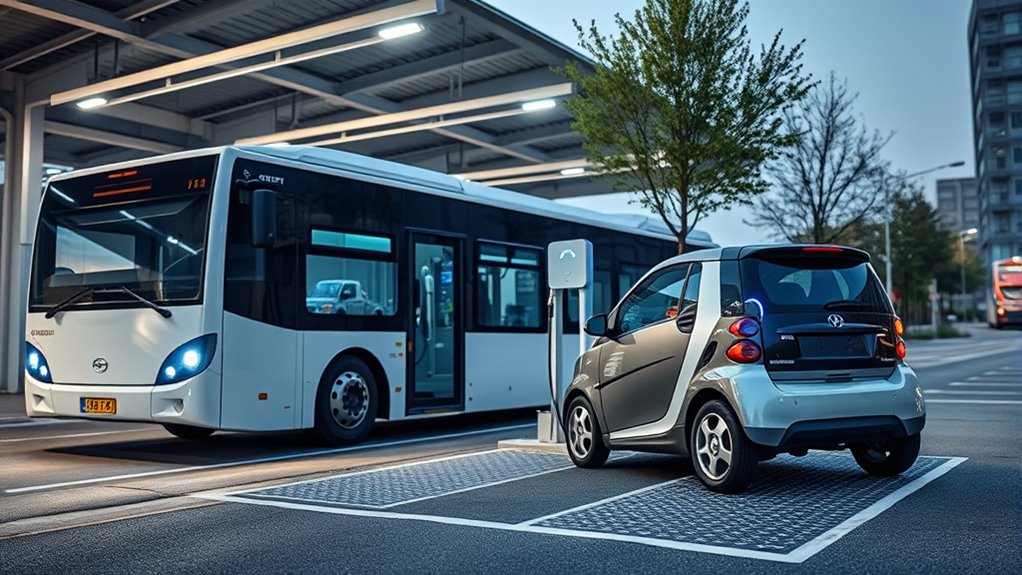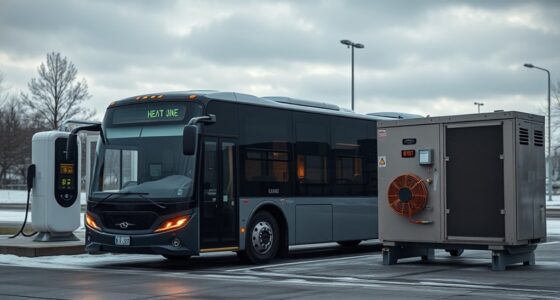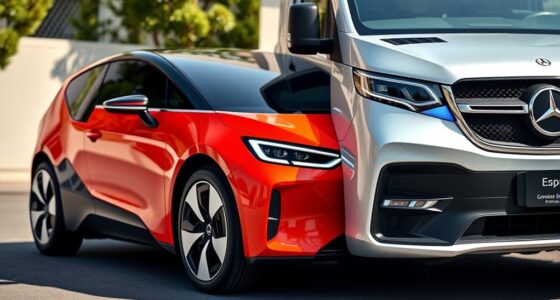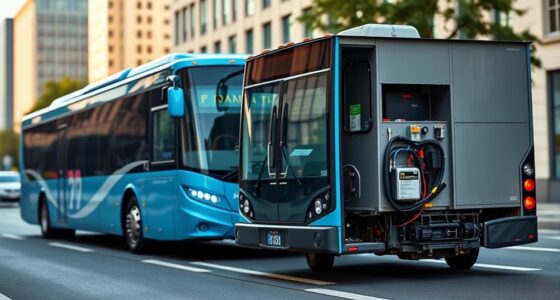When choosing between depot, opportunity, and wireless charging, consider your operational needs. Depot charging is ideal for fleet operations, offering controlled, overnight charging to extend battery life. Opportunity charging provides quick top-ups during short stops, perfect for public transport or delivery vehicles, but may impact battery longevity with frequent cycles. Wireless charging offers seamless convenience but requires significant infrastructure investment. To find the best fit for your operations, explore the differences and benefits of each method carefully.
Key Takeaways
- Depot charging is centralized and ideal for fleet overnight charging, ensuring consistent battery maintenance and longer lifespan.
- Opportunity charging offers quick power boosts during short stops, maximizing operational flexibility with frequent, rapid sessions.
- Wireless charging provides seamless, contactless power transfer, enhancing convenience but requiring significant infrastructure investment.
- Charging method impacts battery management strategies, with depot charging simplifying oversight and opportunity or wireless charging demanding advanced systems.
- Operational needs and infrastructure availability influence the choice, balancing convenience, cost, and battery longevity considerations.

Have you ever wondered how different charging methods affect the performance and convenience of your devices? When it comes to electric vehicles or even industrial equipment, the choice of charging method can make a big difference in how you manage your operations daily. One key factor to consider is battery management, which involves optimizing how batteries are charged and maintained to extend their lifespan and ensure reliable performance. The effectiveness of this management heavily depends on the charging infrastructure available. A well-designed charging infrastructure supports various methods, each with its own benefits and limitations.
Depot charging is a popular approach, especially for fleet operations or facilities where vehicles can be parked for extended periods. With depot charging, you connect your vehicles to dedicated charging stations at a central location. This method allows for controlled and consistent charging, making it easier to manage battery health. Because vehicles are parked overnight or during downtimes, you can schedule charging to optimize battery longevity. The infrastructure needed for depot charging is typically more substantial, requiring high-capacity chargers and dedicated space. This setup simplifies battery management, as you can monitor and maintain batteries centrally, reducing the risk of uneven wear and ensuring your fleet stays ready for use.
Depot charging enables controlled, centralized battery management for fleets with overnight or extended parking.
Opportunity charging takes a different approach, offering quick boosts of power during short stops. This method is especially useful for public transportation or delivery services where vehicles frequently pause at various points throughout the day. Opportunity charging relies on a widespread charging infrastructure, often with fast chargers positioned at strategic locations. Since this method involves frequent, short charging sessions, it demands robust battery management systems to prevent overcharging and overheating. While it provides flexibility and reduces downtime, the frequent charging cycles can impact battery lifespan if not carefully managed. Thus, integrating sophisticated battery management systems becomes vital to balance convenience with long-term battery health.
Wireless charging introduces a futuristic and seamless option, eliminating the need for physical connectors. You simply park your vehicle or device over a charging pad, and power is transferred wirelessly through electromagnetic fields. While still emerging in many sectors, wireless charging offers unparalleled convenience and can be integrated into existing charging infrastructure with minimal physical space requirements. Battery management in wireless systems involves precise control to ensure efficient energy transfer and prevent battery stress or damage. As wireless charging networks expand, they promise to simplify charging routines further, but they also require significant investment in infrastructure and advanced battery management technologies to optimize performance and maintain battery longevity. Additionally, advancements in recycled products and sustainable materials are being incorporated into some charging stations to promote environmental responsibility.
Ultimately, your choice among depot, opportunity, or wireless charging depends on your operational needs, available infrastructure, and how much you prioritize convenience versus battery health. Each method influences how you manage batteries and the charging infrastructure, shaping your overall experience with device performance and reliability.
Frequently Asked Questions
How Do Charging Methods Impact Overall Vehicle Lifespan?
Charging methods crucially impact your vehicle’s lifespan by influencing battery degradation and charging cycle impact. Frequent opportunity charging or wireless charging can lead to rapid battery wear if not managed properly, reducing overall battery life. Depot charging, with controlled and consistent routines, helps minimize battery stress, extending its lifespan. By choosing the right method, you can optimize your vehicle’s longevity and ensure reliable performance over time.
What Are the Safety Considerations for Each Charging Method?
Charging methods can be as safe as a fortress if you manage battery thermal and electromagnetic interference properly. With depot charging, guarantee thermal management systems prevent overheating, while wireless charging needs shielding against electromagnetic interference. Opportunity charging demands strict protocols to avoid sparks or electrical hazards. Always follow manufacturer guidelines, keep equipment well-maintained, and monitor thermal and electromagnetic factors to safeguard yourself and your vehicle effectively.
How Do Charging Times Compare Among Depot, Opportunity, and Wireless Charging?
You’ll find depot charging typically takes longer, often several hours, due to larger battery capacity and power supply needs, but it offers reliable power supply and controlled charging conditions. Opportunity charging is quicker, often under 30 minutes, thanks to high power levels at accessible charging stations, but relies heavily on station accessibility. Wireless charging offers convenience and moderate charging times, around 30-60 minutes, depending on power transfer efficiency and station availability.
Are There Compatibility Issues Between Different Charging Methods?
You might face charging compatibility issues when trying to switch between different methods, as each one often requires specific connectors or infrastructure. Method integration can be challenging if your vehicle’s charging system isn’t designed for multiple approaches, potentially limiting your options. To guarantee seamless operation, check your vehicle’s compatibility with various charging methods and consider investing in adaptable charging stations that support multiple types.
What Is the Cost Difference for Installing Each Charging Type?
You’ll find that installation costs vary considerably between charging methods, with depot charging usually requiring the most upfront investment due to infrastructure needs. Opportunity charging tends to be more cost-effective initially but may incur higher maintenance expenses over time. Wireless charging, while offering convenience, often involves higher installation costs because of advanced technology and infrastructure. Consider both installation costs and ongoing maintenance expenses to determine the most economical option for your needs.
Conclusion
In choosing your charging challenge, consider the convenience of depot, the curiosity of opportunity, or the comfort of wireless. Each method offers unique advantages, allowing you to customize your charging chase. By weighing the wins and woes, you’ll walk wiser in your wireless wonderland. Whichever way you go, make sure your move is mindful, maximizing efficiency while minimizing downtime. Master your method, and keep moving forward without missing a beat.









